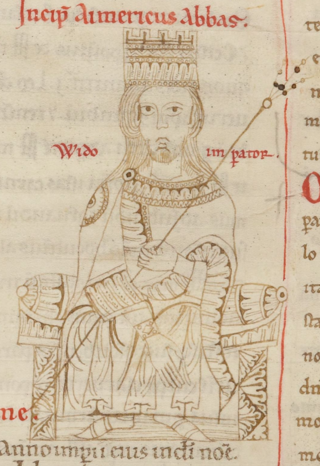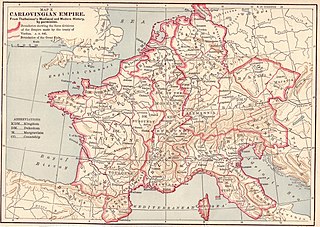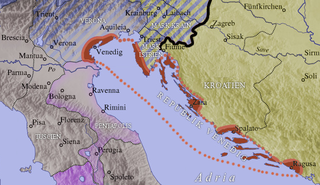History
Upon the deposition of the Carolingian king Charles the Fat by his nephew Arnulf of Carinthia in 887, the power in Italy was assumed by the Unruoching margrave Berengar of Friuli, who received the Iron Crown of the Lombards from the hands of Archbishop Anselm II of Milan. Arnulf, King of East Francia marched against Italy to gain the Lombard crown for himself and Berengar chose to pay homage to him, which led to discord with the Italian nobility. They supported the ambitious Duke Guy III of Spoleto, who had just failed to succeed Charles in West Francia, but now with the support of Archbishop Anselm and Pope Stephen V prevailed against Berengar and had himself crowned King of Italy at Pavia in 889.
Guy had created the March of Ivrea for his vassal Anscar in 888. Anscar and his relatives had been some of Guy's supporters in his failed quest for the French throne. The initial Eporedian march consisted of Piedmont and most of the Ligurian coast with the counties of Acqui, Alba, Asti, Bredulo, Auriate, Turin, Ivrea, Vercelli, Pombia, Stazzona, Bulgaria, Lomello, Savona, and Ventimiglia. Anscar remained a loyal supporter of Guy and his son Lambert, even when King Arnulf called by Pope Formosus again invaded Italy in 894. Upon Lambert's disposition in 896 however, he turned to his rival Berengar of Friuli, who managed to secure his rule in Italy after Arnulf's death in 899. In 902 Anscar bequested the lands of Ivrea to his son Adalbert I, who had married Berengar's daughter Gisela.
Adalbert however was on bad terms with his father-in-law: together with Margrave Adalbert II of Tuscany he backed Berengar's Bosonid rival Louis the Blind, King of Lower Burgundy (Provence). Louis was defeated and Adalbert had to flee from his margraviate to neighbouring Provence, nevertheless he returned with his new ally King Rudolph II, King of Upper Burgundy, both finally defeated Berengar at the 923 Battle of Firenzuola. Even after Rudolph had to cede Italy to Hugh of Provence in 926, the Anscarid fortunes rose in the middle of the century and some margraves became kings of Italy, but in the early eleventh century the margraviate fell vacant and the Emperor Conrad II did not appoint a new margrave.

King of Italy was the title given to the ruler of the Kingdom of Italy after the fall of the Western Roman Empire. The first to take the title was Odoacer, a barbarian military leader, in the late 5th century, followed by the Ostrogothic kings up to the mid-6th century. With the Frankish conquest of Italy in the 8th century, the Carolingians assumed the title, which was maintained by subsequent Holy Roman Emperors throughout the Middle Ages. The last Emperor to claim the title was Charles V in the 16th century. During this period, the holders of the title were crowned with the Iron Crown of Lombardy.

Berengar I was the king of Italy from 887. He was Holy Roman Emperor between 915 and his death in 924. He is usually known as Berengar of Friuli, since he ruled the March of Friuli from 874 until at least 890, but he had lost control of the region by 896.

Berengar II was the King of Italy from 950 until his deposition in 961. He was a scion of the Anscarid and Unruoching dynasties, and was named after his maternal grandfather, Berengar I. He succeeded his father as Margrave of Ivrea around 923, and after 940 led the aristocratic opposition to kings Hugh and Lothair II. In 950 he succeeded the latter and had his son, Adalbert crowned as his co-ruler. In 952 he recognised the suzerainty of Otto I of Germany, but he later joined a revolt against him. In 960 he invaded the Papal States, and the next year his kingdom was conquered by Otto. Berengar remained at large until his surrender in 964. He died imprisoned in Germany two years later.

Guy III of Spoleto was the margrave of Camerino from 880 and then duke of Spoleto and Camerino from 883. He was crowned king of Italy in 889 and emperor in 891. He died in 894 while fighting for control of the Italian Peninsula.

The Kingdom of Upper Burgundy was a Frankish dominion established in 888 by the Welf king Rudolph I of Burgundy on the territory of former Middle Francia. It grew out of the Carolingian margraviate of Transjurane Burgundy southeast of ('beyond') the Jura Mountains together with the adjacent County of Burgundy (Franche-Comté) in the northwest. The adjective 'upper' refers to its location further up the Rhône river, as distinct from Lower Burgundy and also from the Duchy of Burgundy west of the Saône river. Upper Burgundy was reunited with the Kingdom of Lower Burgundy in 933 to form the Kingdom of Burgundy, later known as Kingdom of Arles or Arelat.

Adalbert was the king of Italy from 950 until 961, ruling jointly with his father, Berengar II. After their deposition, Adalbert continued to claim the Italian kingdom until his defeat in battle by the forces of Otto I in 965. Since he was the second Adalbert in his family, the Anscarids, he is sometimes numbered Adalbert II. His name is occasionally, especially in older works, shortened to Albert.

Anscar I was the margrave of Ivrea from 888 to his death. From 877 or 879, he was the count of Oscheret in Burgundy. He supported Guy III of Spoleto for the throne of France after the deposition of Charles the Fat in 887, but after Guy's failed attempt and the coronation of Odo, he returned with Guy across the Alps, where the duke was elected King of Italy. In gratitude, he created the March of Ivrea in the northeast and invested his Burgundian supporter.
Adalbert I was the margrave of Ivrea, the second of the Anscarid dynasty, from the late 890s until his death. In the intermittent civil war which affected Italy from 888 into the 930s, Adalbert initially strove to remain neutral, but from 901 on he sided sequentially with every claimant to the Italian throne.

The Anscarids or the House of Ivrea were a medieval dynasty of Frankish origin which rose to prominence in Northern Italy in the tenth century, even briefly holding the Italian throne. The main branch ruled the County of Burgundy from the eleventh to fourteenth centuries and it was one of their members who first declared himself a count palatine. The cadet Castilian branch of Ivrea ruled the Kingdom of Galicia from 1111 and the Kingdoms of Castile and León from 1126 until 1369. The House of Trastámara, which ruled in Castile, Aragon, Naples, and Navarre at various points between the late 14th and early 16th centuries, was an illegitimate cadet branch of that family.
Willa, known as Willa of Tuscany (911/912–970), was a medieval noblewoman. By birth, she was a member of the Bosonid noble dynasty. By marriage to Berengar II of Italy she was Countess of Ivrea from 930 to 963, and queen consort of Italy from 950 to 963.
Bertila of Spoleto was the wife of Berengar I of Italy, and by marriage Queen consort of Italy and Holy Roman Empress.

The March of Friuli was a Carolingian frontier march, established in 776 as the continuation of the Lombard Duchy of Friuli, established against the Slavs and Avars. It was ceded to the Duchy of Bavaria as the March of Verona in 952. Its territory comprised parts of modern-day Italy, Slovenia and Croatia.

The March of Istria was originally a Carolingian frontier march covering the Istrian peninsula and surrounding territory conquered by Charlemagne's son Pepin of Italy in 789. After 1364, it was the Istrian province of the Habsburg monarchy, the Austrian Empire and Austria-Hungary.
Anscar was a magnate in the Kingdom of Italy who served as Count of Pavia, Margrave of Ivrea (929–36) and Duke of Spoleto (936–40). He is sometimes numbered "Anscar II" to distinguish him from his grandfather, Anscar I of Ivrea. Described by Liutprand of Cremona as courageous and impulsive, he died in the battle of Spoleto.
Milo was the Count of Verona from 931 until 955. He was a vassal of four successive kings of Italy from 910. Under Berengar I he became a courtier (familiaris) and by 924 head of the bodyguard. By 927 he had expanded his landholdings to have vassals of his own. Under Hugh, he revolted twice but kept his position in Verona. Under Berengar II, he was raised to the rank of margrave (marchio) in 953.
Ermengarde of Tuscany was a medieval Italian noblewoman. She was the daughter of Bertha of Lotharingia and Adalbert II, Margrave of Tuscany. She was countess of Ivrea through marriage to Adalbert I of Ivrea. Alongside her half-brother Hugh of Italy Ermengarde was an important opponent of Rudolf II of Burgundy’s rule in Italy.
Gisela of Friuli was a medieval Italian noblewoman. She was the daughter of Berengar I of Italy and Bertila of Spoleto. Through her marriage to Adalbert I of Ivrea, Gisela was countess of Ivrea, and mother of Berengar II of Italy.









